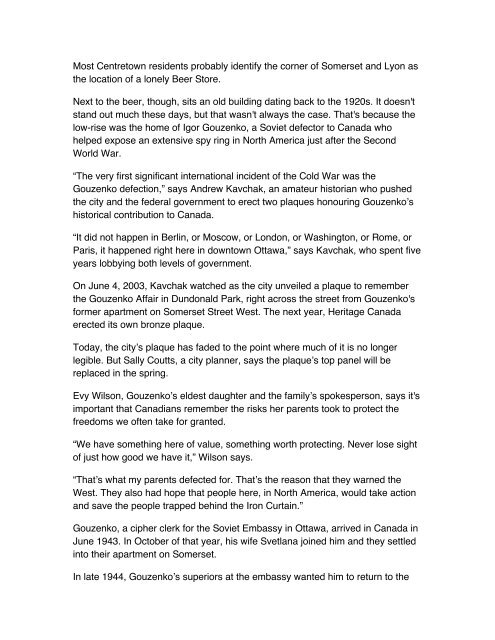Most Centretown residents probably identify the corner of Somerset ...
Most Centretown residents probably identify the corner of Somerset ...
Most Centretown residents probably identify the corner of Somerset ...
You also want an ePaper? Increase the reach of your titles
YUMPU automatically turns print PDFs into web optimized ePapers that Google loves.
<strong>Most</strong> <strong>Centretown</strong> <strong>residents</strong> <strong>probably</strong> <strong>identify</strong> <strong>the</strong> <strong>corner</strong> <strong>of</strong> <strong>Somerset</strong> and Lyon as<br />
<strong>the</strong> location <strong>of</strong> a lonely Beer Store.<br />
Next to <strong>the</strong> beer, though, sits an old building dating back to <strong>the</strong> 1920s. It doesn't<br />
stand out much <strong>the</strong>se days, but that wasn't always <strong>the</strong> case. That's because <strong>the</strong><br />
low-rise was <strong>the</strong> home <strong>of</strong> Igor Gouzenko, a Soviet defector to Canada who<br />
helped expose an extensive spy ring in North America just after <strong>the</strong> Second<br />
World War.<br />
“The very first significant international incident <strong>of</strong> <strong>the</strong> Cold War was <strong>the</strong><br />
Gouzenko defection,” says Andrew Kavchak, an amateur historian who pushed<br />
<strong>the</strong> city and <strong>the</strong> federal government to erect two plaques honouring Gouzenkoʼs<br />
historical contribution to Canada.<br />
“It did not happen in Berlin, or Moscow, or London, or Washington, or Rome, or<br />
Paris, it happened right here in downtown Ottawa,” says Kavchak, who spent five<br />
years lobbying both levels <strong>of</strong> government.<br />
On June 4, 2003, Kavchak watched as <strong>the</strong> city unveiled a plaque to remember<br />
<strong>the</strong> Gouzenko Affair in Dundonald Park, right across <strong>the</strong> street from Gouzenko's<br />
former apartment on <strong>Somerset</strong> Street West. The next year, Heritage Canada<br />
erected its own bronze plaque.<br />
Today, <strong>the</strong> cityʼs plaque has faded to <strong>the</strong> point where much <strong>of</strong> it is no longer<br />
legible. But Sally Coutts, a city planner, says <strong>the</strong> plaqueʼs top panel will be<br />
replaced in <strong>the</strong> spring.<br />
Evy Wilson, Gouzenkoʼs eldest daughter and <strong>the</strong> familyʼs spokesperson, says it's<br />
important that Canadians remember <strong>the</strong> risks her parents took to protect <strong>the</strong><br />
freedoms we <strong>of</strong>ten take for granted.<br />
“We have something here <strong>of</strong> value, something worth protecting. Never lose sight<br />
<strong>of</strong> just how good we have it,” Wilson says.<br />
“Thatʼs what my parents defected for. Thatʼs <strong>the</strong> reason that <strong>the</strong>y warned <strong>the</strong><br />
West. They also had hope that people here, in North America, would take action<br />
and save <strong>the</strong> people trapped behind <strong>the</strong> Iron Curtain.”<br />
Gouzenko, a cipher clerk for <strong>the</strong> Soviet Embassy in Ottawa, arrived in Canada in<br />
June 1943. In October <strong>of</strong> that year, his wife Svetlana joined him and <strong>the</strong>y settled<br />
into <strong>the</strong>ir apartment on <strong>Somerset</strong>.<br />
In late 1944, Gouzenkoʼs superiors at <strong>the</strong> embassy wanted him to return to <strong>the</strong>
Soviet Union. He was able to extend his stay in Ottawa for nearly a year, but<br />
soon realized that time was running out. He had grown fond <strong>of</strong> <strong>the</strong> freedoms he<br />
came to enjoy in Canada, and wanted to secure a better future for his family.<br />
On Sept. 5, 1945, Gouzenko stole 109 documents from <strong>the</strong> Soviet Embassy on<br />
Charlotte Street. The documents included evidence <strong>of</strong> Soviet espionage in <strong>the</strong><br />
West and plans to develop an atomic bomb, which had just been detonated in<br />
Hiroshima and Nagasaki.<br />
Gouzenko and his wife were now fugitives on <strong>the</strong> run from <strong>the</strong> NKVD, <strong>the</strong> Soviet<br />
secret police force that later became <strong>the</strong> KGB.<br />
“She [Svetlana] and he decided toge<strong>the</strong>r that no matter what, <strong>the</strong>y had to warn<br />
<strong>the</strong> West, and <strong>the</strong>y did not expect to survive,” Wilson says.<br />
It was only after NKVD agents were found snooping around his apartment on<br />
Sept. 6 that <strong>the</strong> RCMP took Gouzenko seriously and gave his documents to <strong>the</strong><br />
proper authorities.<br />
On Feb. 3, 1946, an NBC reporter broke <strong>the</strong> news that <strong>the</strong>re was a Soviet spy<br />
ring operating in Canada. Later than month and again in March, authorities<br />
arrested a number <strong>of</strong> alleged spies, including 13 in a series <strong>of</strong> raids on Feb. 15<br />
and 16.<br />
Meanwhile, Gouzenko and his wife were debriefed at a secret base called Camp<br />
X and had to change <strong>the</strong>ir identities to protect <strong>the</strong>mselves and <strong>the</strong>ir family.<br />
Wilson says she only found out about her parentsʼ past when she was a<br />
teenager.<br />
“He was a good man,” she says about her fa<strong>the</strong>r. “Even without <strong>the</strong> history and<br />
<strong>the</strong> knowledge <strong>of</strong> what his background was, just as a dad he was great.”<br />
For its part, <strong>the</strong> building on <strong>Somerset</strong> was never considered for heritage status.<br />
“Our approach to it has been that in many ways, <strong>the</strong> story is more important than<br />
<strong>the</strong> building,” says Coutts. “So we chose to have that interpretive panel so <strong>the</strong><br />
story can be known.”<br />
Kavchak says his dream is for <strong>the</strong> building to become a spy museum, but he<br />
admits that is not likely to happen.<br />
“The city already has <strong>the</strong> Diefenbunker, which is Ottawaʼs Cold War museum,”<br />
says David Flemming, <strong>the</strong> president <strong>of</strong> Heritage Ottawa.
Wilson says she hopes <strong>the</strong> building is preserved in its current state for many<br />
years, but would not want to impose heritage status that could limit development<br />
on <strong>the</strong> block.


